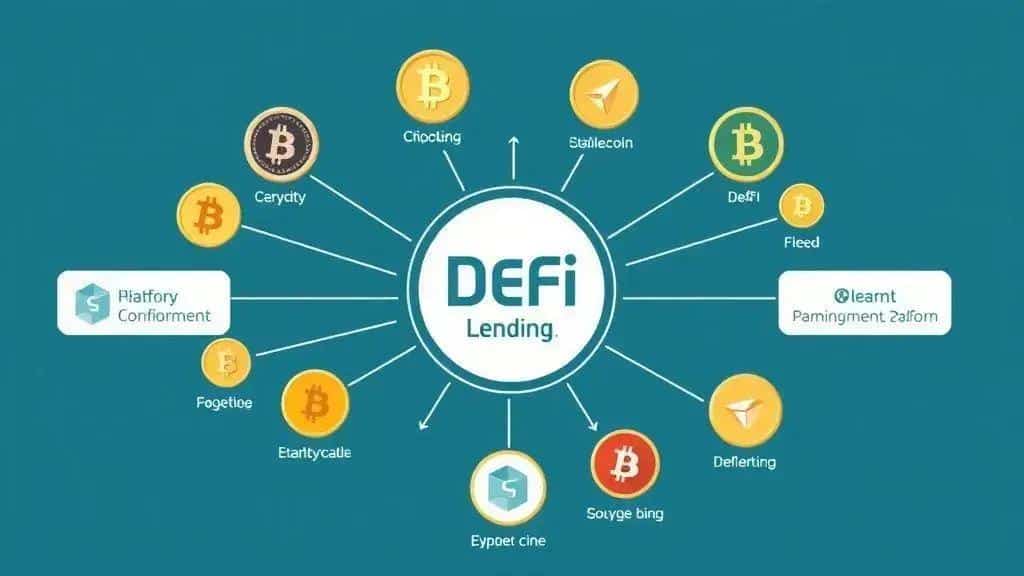Risk management in DeFi lending: securing your investments

Risk management in DeFi lending involves strategies like diversification, market analysis, and insurance to protect investments from volatility and potential losses.
Risk management in DeFi lending is becoming increasingly important as this sector grows. Are you aware of how to protect your investments from potential pitfalls? In this article, we’ll discuss the essential strategies that can help safeguard your assets.
Understanding DeFi lending risks
Understanding the risks associated with DeFi lending is crucial for anyone looking to invest in this area. The decentralized finance space can offer amazing opportunities, but it also comes with a fair share of challenges. In this section, we will explore the most significant risks you should be aware of.
Market Volatility
One of the primary risks in DeFi lending is market volatility. Prices of cryptocurrencies can change rapidly, impacting the collateral value.
- Investors may face significant losses if collateral value drops.
- Unexpected price movements can trigger liquidation events.
- Understanding market trends can cushion against this risk.
Alongside market volatility, smart contract vulnerabilities present another significant threat. Smart contracts are essential to DeFi operations, but they are not immune to bugs or exploits.
Smart Contract Risks
While smart contracts automate processes, any coding errors can lead to substantial financial losses. These vulnerabilities arise due to:
- Poor coding practices by developers.
- A lack of thorough audits before deployment.
- Emerging threats from hackers targeting weaknesses.
Another crucial aspect is liquidity risk in DeFi lending platforms. Investors must ensure that sufficient liquidity exists to avoid encountering withdrawal issues.
If a platform lacks adequate liquidity, it can become harder to withdraw assets during market stress. Always check if the lending platform maintains a healthy level of liquidity to protect yourself.
Finally, regulatory risks cannot be overlooked. They can impact how DeFi lending operates and whether platforms can remain functional in the market.
Potential future regulations may force changes in lending practices, affecting the overall landscape of decentralized finance. Awareness of these potential shifts is crucial for any investor.
By understanding these risks, you equip yourself with knowledge that can help you navigate the complexities of DeFi lending successfully, making it essential to stay informed.
Key strategies for effective risk management
Key strategies for effective risk management in DeFi lending can empower investors to protect their assets and enhance potential returns. Understanding how to implement these strategies can significantly reduce exposure to various risks.
Diversification
One of the most effective practices is diversification. Spreading your investments across different assets can help manage risk.
- Invest in multiple cryptocurrencies.
- Use various lending platforms to mitigate platform-specific risks.
- Consider mixing DeFi investments with traditional assets.
Another strategy is to conduct thorough due diligence on the platforms used. Knowing the platform’s security history and liquidity metrics is vital.
Conducting Due Diligence
Take time to research and understand the projects you invest in. Key considerations include:
- The team behind the project and their track record.
- The underlying technology and its security.
- The community and market position of the platform.
Monitoring market conditions is essential for effective risk management. Staying updated on crypto news and market analysis will help you make informed decisions.
Additionally, using tools such as stop-loss orders can protect against significant losses. By setting a predetermined price at which to sell an asset, you limit potential downsides.
Having a robust exit strategy is equally important. Knowing when to exit a position can save you from unnecessary losses during market downturns. This strategic foresight allows better control over your investments.
By adopting these strategies, you create a solid foundation for risk management, which enhances the sustainability of your DeFi lending ventures.
Diversification: A vital component

Diversification is a vital component of risk management in DeFi lending. By spreading your investments, you can reduce the impact of any single asset’s poor performance. This strategy helps in safeguarding your capital while allowing for potential gains.
Why Diversification Matters
In the volatile world of cryptocurrencies, unexpected price changes can occur frequently. If you invest all your funds in one asset, you risk significant losses if that asset declines in value.
- Spreading investments lowers exposure to market volatility.
- Diversification increases the chances of benefiting from high-performing assets.
- Allocating funds across different projects mitigates systemic risk.
It’s important to choose a mix of assets that complement each other. For example, combining stablecoins with high-risk tokens can balance the overall risk.
Strategies for Effective Diversification
To effectively diversify your DeFi investments, consider these strategies:
- Invest in multiple types of assets, such as governance tokens, stablecoins, and utility tokens.
- Explore different lending platforms, as each may offer unique opportunities and risks.
- Keep an eye on sectors within DeFi, such as lending, borrowing, and liquidity pools.
Regularly review your portfolio to ensure it remains balanced. As market conditions change, adjustments may be necessary. This ongoing evaluation helps maintain effective diversification.
By embracing diversification, you create a stronger investment approach that buffers against unexpected downturns while maximizing growth potential. Remember, an informed strategy can lead to better long-term results in DeFi lending.
The role of insurance in DeFi lending
The role of insurance in DeFi lending is crucial for mitigating risks and protecting assets. In this volatile market, having insurance can provide peace of mind and enhance investor confidence.
Understanding DeFi Insurance
DeFi insurance serves as a safety net, covering potential losses from specific events, such as smart contract bugs or hacking incidents. Security breaches in DeFi protocols can result in substantial financial losses, making insurance an appealing option for investors.
- Insurance can protect against smart contract vulnerabilities.
- It helps investors feel more secure in their investments.
- Coverage can vary, so it’s essential to understand policy details.
As DeFi evolves, many new platforms are emerging that offer insurance solutions. Understanding how these policies work can empower you to choose the right protection for your investments.
Types of Insurance Available
Several types of DeFi insurance can help protect your capital. These include:
- Smart Contract Insurance: Covers losses from bugs or vulnerabilities in the code.
- Custodial Insurance: Protects assets held in a wallet against theft or loss.
- Protocol Insurance: Covers funds within specific platforms from risks associated with their operational processes.
Before purchasing any insurance, carefully read the terms. Each policy may have exclusions and limitations, which could influence your protection level. The cost of insurance can vary widely depending on the coverage amount and the specific risks involved.
Investing in DeFi insurance allows you to participate in this exciting financial space while minimizing potential downsides. By understanding and utilizing insurance options, you can manage risk more effectively, making your investments more secure.
Analyzing market trends for better decisions
Analyzing market trends is essential for making better decisions in DeFi lending. By keeping an eye on market movements, you can adapt your strategies and identify the best opportunities available.
Importance of Market Analysis
Market analysis allows investors to understand the dynamics affecting asset prices. This understanding can significantly influence the timing of your investments.
- It helps predict potential price fluctuations.
- Investors can identify strong and weak assets.
- Being informed aids in making timely financial decisions.
Moreover, awareness of market trends enables better management of risks. When you know what factors are influencing the market, you can react more strategically to sudden changes.
Key Indicators to Watch
Several indicators can help you analyze market trends effectively. Key metrics include:
- Volume: High trading volume often indicates strong market interest.
- Price Movements: Sudden changes in price can signal shifts in market sentiment.
- Market Sentiment: Social media and news outlets can provide insights into the general feelings of investors.
Additionally, utilizing charts and technical analysis can provide deeper insights. Charts can reveal patterns that help in forecasting future price movements.
It’s also wise to consider broader economic factors that might influence the crypto market, including regulations and macroeconomic trends. By staying informed about external influences, you can better prepare for changes in the DeFi landscape.
Overall, staying on top of market trends is not just beneficial; it’s critical for engaging successfully in DeFi lending. Your ability to analyze and interpret market information can lead to better investment outcomes.
In conclusion, understanding risk management in DeFi lending is crucial for safeguarding your investments. Key strategies such as diversification, thorough market analysis, and the role of insurance can help you navigate this complex financial landscape. By leveraging these approaches, you can minimize potential risks and maximize opportunities in the dynamic world of decentralized finance. Staying informed and adaptable will be your best tools for success.
FAQ – Frequently Asked Questions about Risk Management in DeFi Lending
What is risk management in DeFi lending?
Risk management in DeFi lending involves strategies to minimize potential losses and protect investments from market volatility.
Why is diversification important in DeFi?
Diversification reduces exposure to the risks associated with any single asset or platform, enhancing overall investment stability.
How can I analyze market trends effectively?
Effective market analysis involves monitoring trading volumes, price movements, and general market sentiment to make informed investment decisions.
What role does insurance play in DeFi lending?
Insurance provides a safety net for investors against specific risks like smart contract failures and hacking incidents, adding an extra layer of protection.





